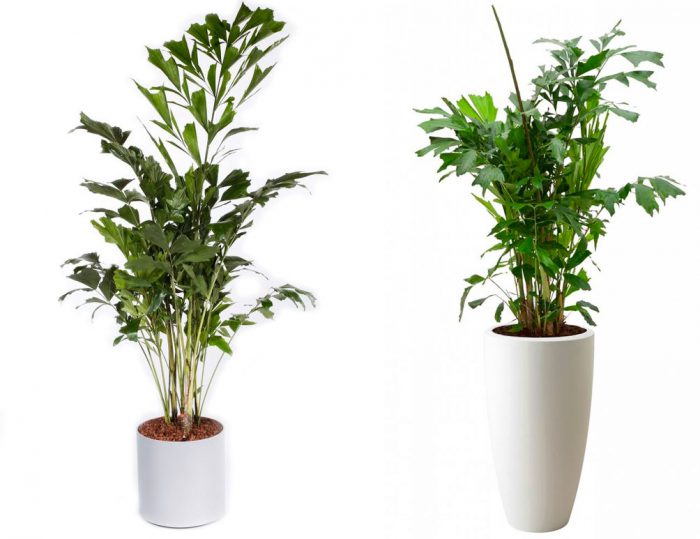Characteristic feature karyote palms are bifurcated leaves with "torn" edges. The shape of these leaves is very similar to a fish's tail.
This genus includes about 12 species of different plants. Under natural conditions, they can be found in Indochina, the Malay Islands, India, and also in Southeast Asia.
An interesting fact is that wine and sugar are prepared from the juice of some types of caryote palms.
Indoor conditions are often grown tender or soft caryota (Caryota mitis).
Under natural conditions, this plant can reach a height of 10 meters, there are specimens and higher.
With proper and good care, this palm tree grows quite quickly in indoor conditions. So, in just a few years, a karyote can grow up to 2.5 meters. If, on the contrary, you need a compact plant, then its growth can be very easily slowed down. To do this, transplanting should be done only as a last resort, when the root system ceases to fit in the pot.
Also, a rather popular species is the stinging caryota (Caryota urens). The plant received this unusual name because its fruits contain oxalic acid salts. The leaves of such a palm tree have a triangular shape. This type of karyota is also quite tall and can reach a height of 2.5 meters. This plant is also called wine caryote.
Content
Caring for a caryote palm at home
Temperature regime
Try to keep the temperature in the room where the caryote is located at a level of 14 to 18 degrees throughout the year. The fact is that this plant grows normally and develops only at moderate temperatures. Even on hot summer days, try to keep the room temperature below 18 degrees. In the event that it is warmer in the room, you need to spray the foliage as often as possible. In winter, make sure that the air temperature is not below 13 degrees.
Illumination
Needs moderately bright lighting. This plant is quite light-requiring, but it should be protected from direct sunlight, as they can harm the palm tree. It is recommended to place it near a south-east or south-west orientation window. In winter, the illumination should also be bright enough.
How to water
In the spring and summer period, you need to water the palm abundantly. However, it is necessary to ensure that water does not stagnate in the soil. In winter, moderate watering is needed, while the substrate in the pot should be constantly slightly moistened.
Moisturizing
For spraying, you need to use well-settled soft lukewarm water. In the event that the cariota is placed in the immediate vicinity of a working heating device, it must be humidified from a sprayer in the morning and evening hours. In winter, foliage is moistened somewhat less often.
Earth mix
A suitable dredge should be neutral or slightly acidic. To prepare an earthen mixture, it is necessary to combine humus-leaf and clay-sod soil taken in equal parts, and also add rotted manure, peat and sand. Purchased soil for palm trees is quite suitable for planting.
Fertilizer
The palm is fed from May to September 1 time in 2-4 weeks. For this, special fertilizers for palm trees are suitable.
Transplant features
This plant does not tolerate transplantation well enough, therefore, this procedure should be carried out only in case of emergency, for example, when the overgrown root system ceases to fit in the pot.
Reproduction methods
You can propagate by seeds. Sowing is carried out at a centimeter depth in warm, moist soil. Then the container is covered with film or glass. Open the container with seedlings only 2-3 months after sowing. The grown seedlings must be planted in separate pots.
In indoor conditions, such a palm tree almost never blooms.
Pests and diseases
The plant can settle spider mites, mealybugs or scabbards.
A plant can get sick as a result of violations of the rules for caring for it.
- Yellow foliage - too poor watering. Water your palm more often, but make sure that no liquid stagnates in the pot. This may also be due to a lack of nutrients in the substrate, in which case the palm must be fed.
- The tips of the leaves become brownish - due to stagnation of liquid in the ground. Reduce watering, check drainage, and wait for the topsoil to dry thoroughly before watering the caryote.
- Darkening and wilting of foliage - the room is too cold.
- Pale dry spots appear on the foliage surface - too intense lighting. Move the pot to a shaded area.













